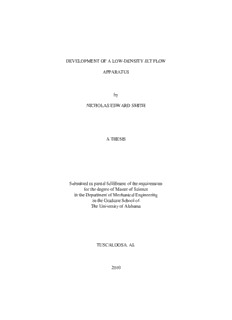Table Of ContentDEVELOPMENT OF A LOW-DENSITY JET FLOW
APPARATUS
by
NICHOLAS EDWARD SMITH
A THESIS
Submitted in partial fulfillment of the requirements
for the degree of Master of Science
in the Department of Mechanical Engineering
in the Graduate School of
The University of Alabama
TUSCALOOSA, AL
2010
Copyright Nicholas Edward Smith 2010
ALL RIGHTS RESERVED
ABSTRACT
An apparatus was designed and constructed to study supersonic fluid flow in a low
temperature and low pressure environment similar to the same conditions associated with near
space. The apparatus allows the visualization of supersonic flows through an annular nozzle
using a shadowgraph system. The flow system that creates supersonic flows is capable of
producing pulsating jets at virtually any frequency.
This thesis includes details of design of a near space jet flow apparatus that is capable of
producing low temperature and low pressure environment for studying annular jets. The annular
jets are produced from a nozzle that may be later incorporated on near space vehicle. After
testing, it was discovered that the apparatus was capable of producing low temperatures and low
pressures, but the results were inconsistent with a near space environment.
The nozzle being studied has a blocking ratio of 0, 0.5 and 0.75. For each blocking ratio,
the flow is choked, producing a constant mass flow rate. The theoretical and actual thrust were
calculated using propulsion equations. The experimental results were compared to the
theoretical, isentropic results. The jet length was also measured as a reference for vehicle design
limitations. It was found that the maximum experimental thrust coefficients for a nozzle with
blocking ratios of zero, 0.5 and 0.75 were calculated to be 0.430, 0.439, and 0.537 respectively.
All maximum thrust coefficients occur at an ambient pressure of 0.5 kPa.
ii
LIST OF ABBREVIATIONS AND SYMBOLS
Discharge coefficient for theoretical model
Discharge coefficient for nozzle
CV Control volume
e Exiting
i Entering
NSJFA Near space jet flow apparatus
Pressure
Heat transfer
Air gas constant
Temperature
Volume
Work
Mass
Mass flow rate
Specific internal energy
Mach number
Velocity or specific volume
Speed of sound
Specific heat ratio
Force (thrust)
iii
Uncertainty
Time
Change
iv
ACKNOWLEDGEMENTS
First and foremost I would like to thank God, my family, and Catherine for supporting
me and providing me the opportunity to continue my education. I would like to thank Dr. John
Baker for allowing me to work in the Aerothermal Sciences Laboratory and continue my
graduate studies in the Department of Mechanical Engineering at the University of Alabama.
Without his guidance, I would not have been able to achieve my dream of receiving a master‟s
degree in mechanical engineering. I would also like to thank my committee members Dr. Bob
Taylor and Dr. Paul Ray.
I would also like to thank Matt Fitzgerald and Arnar Thors from FitzThors Mechanical,
Brandon Griffin, and the employees in the engineering machine shop for assisting me with my
project construction. I would also like to thank Donald Smith from CNX gas for donating
various parts for my project. I also want to thank Jason Cottingham for helping me with my
project construction and Brian Lozes for helping me develop a Matlab code.
v
CONTENTS
ABSTRACT .................................................................................................................................... ii
LIST OF ABBREVIATIONS AND SYMBOLS .......................................................................... iii
ACKNOWLEDGEMENTS ............................................................................................................v
LIST OF TABLES ......................................................................................................................... vi
LIST OF FIGURES .................................................................................................................... .vii
1. INTRODUCTION .....................................................................................................................1
1.1. NEAR SPACE ....................................................................................................................1
1.2. STATION-KEEPING .........................................................................................................3
1.3. MOTIVATION ...................................................................................................................3
1.4. OUTLINE OF THESIS ......................................................................................................4
2. REVIEW OF LITERATURE ....................................................................................................5
2.1. NEAR SPACE ....................................................................................................................5
2.2. NOZZLES & JET FLOWS ................................................................................................6
3. BACKGROUND .....................................................................................................................10
3.1. JET FLOWS .....................................................................................................................10
3.1.1. CHOKED FLOW...................................................................................................10
3.1.2. MACH NUMBER & FLOW CORRELATIONS..................................................11
3.1.3. NORMAL & OBLIQUE SHOCKS .......................................................................13
3.1.4. THEORETICAL PROPULSION CAPABILITIES ..............................................14
3.1.5. IDEAL NOZZLE FLOW .......................................................................................14
4. THEORETICAL DISCHARGE MODEL ...............................................................................15
4.1. FORMULATION .............................................................................................................15
4.2. IDEAL GAS LAW ...........................................................................................................15
4.3. FIRST LAW OF THERMODYNAMICS: TRANSIENT ................................................16
4.4. THERMODYNAMIC MODEL .......................................................................................16
5. EXPERIMENTAL SETUP ......................................................................................................22
5.1. OVERVIEW .....................................................................................................................22
5.2. THE VACUUM CHAMBER ...........................................................................................22
5.3. THE OBSERVATION CHAMBER.................................................................................23
5.4. VALVE & ACTUATOR ..................................................................................................25
5.5. DATA ACQUISITION SYSTEM ....................................................................................28
5.5.1. MEASUREMENT DEVICES & HARDWARE ...................................................29
5.5.2. DAQ SOFTWARE ................................................................................................33
5.5.3. ADDING A CHANNEL ........................................................................................35
5.6. SHADOWGRAPH SYSTEM ..........................................................................................44
5.7. JET CONFIGURATION ..................................................................................................48
5.7.1. JET HARDWARE .................................................................................................48
5.7.2. JET INSTALLATION ..........................................................................................49
5.7.3. JET FLOW SYSTEM ............................................................................................51
5.7.4. BASIC STAMP FLOW CONTROLLER ..............................................................51
5.8. UNCERTAINTY ANALYSIS .........................................................................................54
5.8.1. MEASUREMENT UNCERTAINTY BACKGROUND ......................................55
5.8.2. LIST OF MEASUREMENT UNCERTAINTY ....................................................55
5.9. THEORETICAL M-FILE ................................................................................................56
6. RESULTS AND DISCUSSION ..............................................................................................58
6.1. THEORETICAL DISCHARGE MODEL ........................................................................58
6.1.1. CASE MATRIX.....................................................................................................58
6.1.2. RESULTS ..............................................................................................................59
6.1.3. DISCUSSION ........................................................................................................61
6.2. EXPERIMENTAL DISCHARGE MODEL.....................................................................61
6.2.1. CASE MATRIX.....................................................................................................62
6.2.2. RESULTS AND DISCUSSION ............................................................................62
7. JET TESTING .........................................................................................................................64
7.1. TESTING METHOD ........................................................................................................64
7.2. RESULTS .........................................................................................................................66
7.2.1. RESULTING EXPERIMENTAL UNCERTAINTY ............................................69
7.3. DISCUSSION ...................................................................................................................71
8. CONCLUSION ........................................................................................................................74
8.1. SUMMARY OF WORK ..................................................................................................74
8.2. FUTURE RESEARCH .....................................................................................................76
9. REFERENCES ........................................................................................................................77
10. APPENDICES .........................................................................................................................80
LIST OF TABLES
Table 1. Coefficients used in calculating equations 21 and 22 ..................................................... 18
Table 2. List of observation chamber components from Duniway Stockroom ............................ 25
Table 3. List of measurement uncertainty..................................................................................... 55
Table 4. Case matrix for theoretical discharge model .................................................................. 59
Table 5. Sample case for various vacuum chamber pressure settings with observation chamber
kept at atmosphere ........................................................................................................................ 60
vi
Description:This thesis includes details of design of a near space jet flow apparatus that is capable of producing low calculated using propulsion equations.

